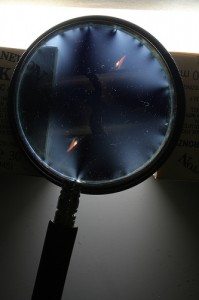 Have you ever watched a television news story or read something in print or online and wondered afterwards what on earth it was about? It happens all too often when stories have no focus. Reporters who spend much of their day collecting information, pictures and sound seem to feel obliged to cram as much as they possibly can into their minute-thirty or less. The end result can be fuzzy at best, and at worst, almost incomprehensible.
Have you ever watched a television news story or read something in print or online and wondered afterwards what on earth it was about? It happens all too often when stories have no focus. Reporters who spend much of their day collecting information, pictures and sound seem to feel obliged to cram as much as they possibly can into their minute-thirty or less. The end result can be fuzzy at best, and at worst, almost incomprehensible.
Try these suggestions for finding a focus for your stories as you’re reporting, and before you start to write. If they help, please let us know.
Think First
Finding a focus means thinking about the story before you start reporting. Instead of rushing to snag the usual suspects, ask a few questions early on to help you figure out the best way to approach today’s assignment. Who has the basic facts about this story and do we need them on camera? Who has personal experience with this and who can put the facts in perspective? Where is the central place of this story and is that where we’re going?
When you get to a location, take just a few minutes to look around. Do a complete 360-degree turn: the real story may be behind you. Don’t be so locked in on what the story is “supposed” to be about that you miss what’s really going on.
If you’re struggling with a broad topic, looking for a story within the story can provide a tighter focus to illustrate the bigger picture. If you have a small story that seems unimportant, finding a story behind the story can reflect a larger trend or theme.
Eliminate
Take time to decide what the story is really about before beginning to write. That sounds obvious, but it’s a step many reporters skip, especially on deadline. Try to sum up your story in just a few words–three can be enough. Put the three words on a sticky note and keep it in sight while you write.
Use your focus statement to help you decide what to leave out of your story. Who and what will not be covered in this story and do you have a good reason for that?
Consider what you want the audience to take away from your story. Will viewers or readers know something after seeing this story that they didn’t know before it aired? If viewers can put this new knowledge to use, have you told them how?
Information that doesn’t fit your focus may be useful for a lead-in or tag, or an info-box. It may suggest another angle on the story for another day.
Choose a Format
Only when you know what you really need to say should you decide how to say it. Too many story ideas are pre-formatted before they’re even reported. On television, a court hearing is always a V/O; a weather story is a live shot. In print, a local event is always a brief.
Consider what approach works best for the story you want to tell. Maybe that brief is a photo essay. Maybe that TV story should be something other than a package: Anchor copy, graphic, V/O, natural sound, live or some combination. Deciding how to tell a story before you even know what it’s about is a disservice to the people you cover and the audience. Finding a focus will help you tell better, stronger stories in any medium. That’s a promise.









3 Comments
[…] Try these suggestions from NewsLab for finding a focus for your stories as you’re reporting, and b… If they help, please let us know. […]
[…] from: NewsLab var a2a_config = a2a_config || {}; a2a_config.linkname="Social media search tips"; […]